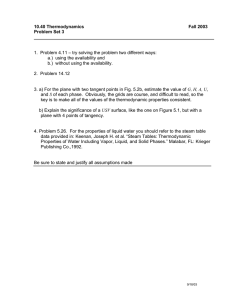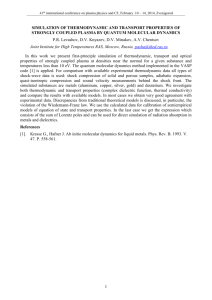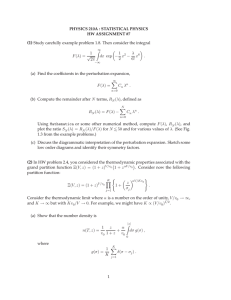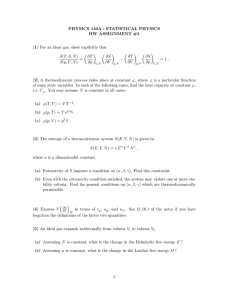Definition of Thermodynamic Phases and Phase Transitions
advertisement
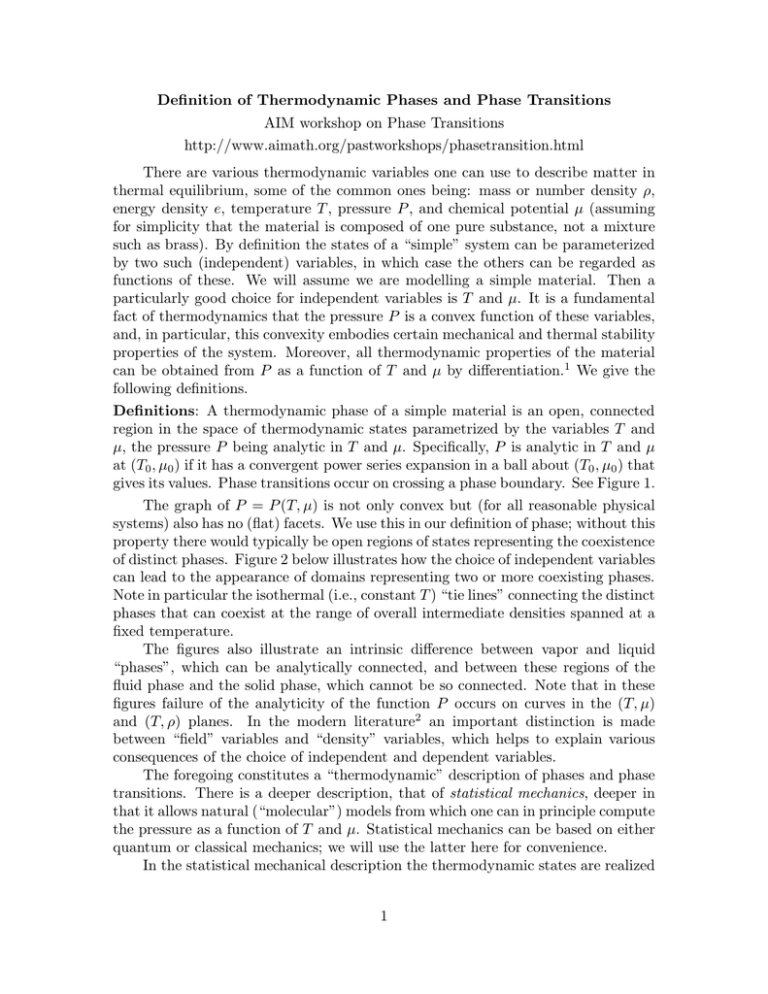
Definition of Thermodynamic Phases and Phase Transitions
AIM workshop on Phase Transitions
http://www.aimath.org/pastworkshops/phasetransition.html
There are various thermodynamic variables one can use to describe matter in
thermal equilibrium, some of the common ones being: mass or number density ρ,
energy density e, temperature T , pressure P , and chemical potential µ (assuming
for simplicity that the material is composed of one pure substance, not a mixture
such as brass). By definition the states of a “simple” system can be parameterized
by two such (independent) variables, in which case the others can be regarded as
functions of these. We will assume we are modelling a simple material. Then a
particularly good choice for independent variables is T and µ. It is a fundamental
fact of thermodynamics that the pressure P is a convex function of these variables,
and, in particular, this convexity embodies certain mechanical and thermal stability
properties of the system. Moreover, all thermodynamic properties of the material
can be obtained from P as a function of T and µ by differentiation.1 We give the
following definitions.
Definitions: A thermodynamic phase of a simple material is an open, connected
region in the space of thermodynamic states parametrized by the variables T and
µ, the pressure P being analytic in T and µ. Specifically, P is analytic in T and µ
at (T0 , µ0 ) if it has a convergent power series expansion in a ball about (T0 , µ0 ) that
gives its values. Phase transitions occur on crossing a phase boundary. See Figure 1.
The graph of P = P (T, µ) is not only convex but (for all reasonable physical
systems) also has no (flat) facets. We use this in our definition of phase; without this
property there would typically be open regions of states representing the coexistence
of distinct phases. Figure 2 below illustrates how the choice of independent variables
can lead to the appearance of domains representing two or more coexisting phases.
Note in particular the isothermal (i.e., constant T ) “tie lines” connecting the distinct
phases that can coexist at the range of overall intermediate densities spanned at a
fixed temperature.
The figures also illustrate an intrinsic difference between vapor and liquid
“phases”, which can be analytically connected, and between these regions of the
fluid phase and the solid phase, which cannot be so connected. Note that in these
figures failure of the analyticity of the function P occurs on curves in the (T, µ)
and (T, ρ) planes. In the modern literature2 an important distinction is made
between “field” variables and “density” variables, which helps to explain various
consequences of the choice of independent and dependent variables.
The foregoing constitutes a “thermodynamic” description of phases and phase
transitions. There is a deeper description, that of statistical mechanics, deeper in
that it allows natural (“molecular”) models from which one can in principle compute
the pressure as a function of T and µ. Statistical mechanics can be based on either
quantum or classical mechanics; we will use the latter here for convenience.
In the statistical mechanical description the thermodynamic states are realized
1
or represented as probability measures on a certain space K, the measures still
parameterized by thermodynamic variables as above (two variables for our simple
system, say, specifically temperature T and chemical potential µ). The space K
is, in a common model of a simple material, the space of all possible positions x
and momenta p of infinitely many point particles. We will use the notation x =
{x1 , x2 , . . .} and p = {x1 , x2 , . . .} to denote the sets of the position and momentum
variables for all the particles.
It is valuable, in particular, to consider a finite system of N particles contained
in a reasonably shaped domain, say Ω, of volume V . In this case the probability
densities, on the disjoint union ∪N SN of the (x, p) spaces SN = ΩN × R3N for N
particles, are proportional to the weights
fN (T, µ; x, p) = e−βEN (x,p)+βµN ,
while the overall normalization constant (or “partition function”) is
∞ Z
X
ΞV (T, µ) = 1 +
dxdpfN (T, µ; x, p),
(1)
(2)
N=1
where β = 1/kB T , kB being Boltzmann’s renowned constant.
The structure of the energy EN is determined only when one settles on the
type of “interactions” the constituent particles can undergo; that not only depends
on the material being modelled but also on what environment (external forces,
etc.) one may want to impose on the system. In the simplest case the particles
are assumed to interact only among themselves, through some translation invariant
“interaction potential” ϕ(xi − xj ) which decays to zero sufficiently rapidly as the
separation |xi − xj | → ∞. The “kinetic energy” of the j th particle is, classically,
p2j /2m, m being the mass of the particle. The total energy is then
EN
X p2j
1 X
+
=
ϕ(xi − xj ).
2m 2
j
(3)
i,j:i6=j
And the so-called “grand canonical” pressure of the finite-volume system is given
by
kB T ln[ΞV (T, µ)]
.
(4)
V
(Note that the convexity of PV (T, µ) is ensured by this formulation.) However, it
is not hard to see for reasonable interaction potentials ϕ that the pressure PV as
a function of T and µ is everywhere analytic. Consequently, in order to model a
sharp phase transition it is necessary to consider the thermodynamic limit3
PV (T, µ) =
P (T, µ) = lim PV (T, µ).
V →∞
(5)
Then P (T, µ) may be identified as the thermodynamic pressure to which our definitions of a phase and a phase transition applies.
2
Footnotes
1. For this reason the function P (T, µ) is referred to as a “thermodynamic potential”. Alternative potentials (for describing the same physical system) follow
by Legendre transforms.
2. R.B. Griffiths and J.C. Wheeler, Phys. Rev. A 2 (1970) 1047-1064.
3. The proof of the existence of the thermodynamic limit requires conditions on
the interaction potential ϕ(x) for |x| → 0 and |x| → ∞ and on the sequence
of domains Ωk as Vk → ∞ with k → ∞. See M.E. Fisher, Arch. Ratl. Mech.
Anal. 17 (1964) 377-410.
Figures
T
µ
Fluid
Temperature
liquid
Chemical potential
Solid
Liquid
Vapor
Critical point
solid
coexistence
Liquid
Solid
Fluid
Critical point
Temperature
T
vapor/liquid
Vapor coexistence
vapor/solid coexistence
Density
Fig 1. A simple phase diagram
in the (µ, T ) plane.
ρ
Fig 2. A simple (T, ρ) diagram
illustrating coexisting phases.
Michael E. Fisher, University of Maryland
Charles Radin, University of Texas
December, 2006
3


